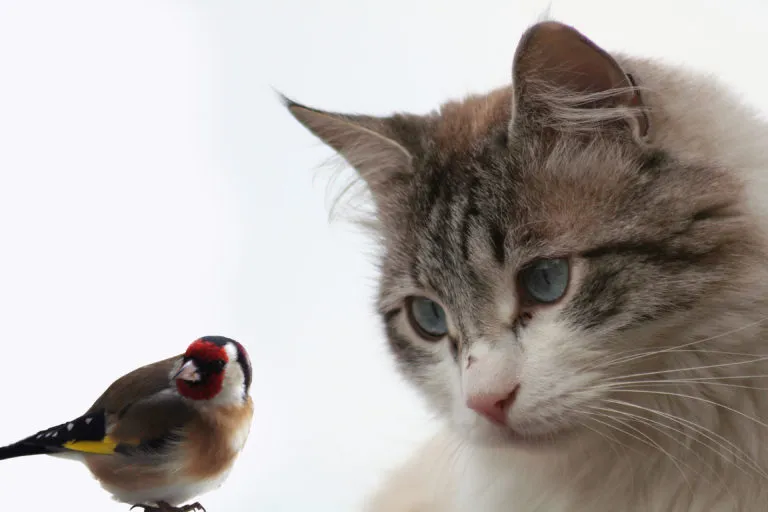46% of UK households own a pet, with a total pet population of 58 million, including 7 million cats and 0.5 million indoor birds. Many pet owners provide a home for more than one type of pet, with cats sometimes sharing a home with a budgie, parakeet or other bird, but what happens when you have a cat and a small pet?
Cats have an innate hunting instinct, and that includes cats that have always lived with humans and have never had to hunt for themselves. In their natural state, cats would prey on small rodents like mice as well as small birds. Domestic birds like budgerigars, parakeets and canaries match your cat’s prey profile perfectly, but it is still possible to keep them in the same household, as long as you take certain safety measures.
Set Realistic Goals
A quick look on any video sharing site will turn up any number of amusing clips of parrots and cats being the best of friends, which could lead you to hope that your budgie and the cat could be friends. However the first thing to remember if you want your cat and your bird to live in harmony is that you need to be realistic. There may be cases where cats accept a pet bird as just another member of the family, but these are rare. The most likely scenario is that your bird and your cat will learn to accept each other, assuming that the cat’s hunting instinct does not take over.
Safety First
It is a fact that animals are driven by instinct, and this is particularly true for cats. Even though they have been domesticated for thousands of years, they are still hunters on the inside. Small, fluttering birds are an ideal snack. Even the calmest of cats still have the instinct to hunt. Your pets‘ safety is always of the greatest importance. Even a single swipe of a paw can be fatal to a budgie or a canary, so you should never allow your cat to have direct access to a pet bird. Even if the bird is in a cage, a cat may be able to get its paw through the bars and injure it, or it might be able to knock a smaller cage over.
That being said, it is not impossible to have a cat and a bird in the same house.
Keeping Birds and Cats in the Same House
So, practially speaking, how do you go about keeping birds and cats in the same home and how do you work things out when a new cat arrives in a house that already has pet birds?
An outdoor aviary is ideal as species-appropriate housing for pet birds and it also makes sure that your indoor cat and your birds do not come into contact often. If you do not have a large garden or you can’t imagine keeping an entire flock of birds, then an indoor cage that can house one or more birds is probably the best solution. To keep your birds and cat away from each other, you should try to make sure that the cat is never in the same room as the birdcage, unless it is supervised. Cages or aviaries need to be well secured and roomy enough that the birds inside can escape from any inquisitive paws that manage to reach inside.
Encouraging your different pets to accept each other is especially important. To encourage your cat not to view a small pet as prey, and to ensure your birds do not feel terror every time the cat appears, it is helpful if you set a good example with your own behaviour. Always treat your birds with respect and dignity and do not allow your cat to view them as a toy. On no account should you tease your cat with small birds. Give your cat lots of attention too, so that it does not become jealous of your other pets.
If your cat keeps lurking by the birdcage, or looks like it may pounce, a clear, loud “No!” helps to set the boundaries of acceptable behaviour. Your pet birds are part of the family and your cat needs to understand that too.
Essentially, prevention is better than anything else. A suitably entertained, well-nourished cat is more likely to have a relaxed attitude to the pet birds that it shares its home with. A calm and relaxed cat can happily view pet birds as ‘Cat TV’ rather than as a potential snack.
Wild Birds
People who love wild birds are often not the biggest fans of cats that are allowed access to the outdoors. As small birds are exactly the type of prey that cats will instinctively hunt down and eat, even the most well-fed amongst them find it hard to resist the seductive flatter of little wings. Adult birds are often able to escape the claws of a cat, but young, sick or older birds are vulnerable. Environmentalists argue that domestic cats are a the biggest danger to native bird species, but as yet there is little concrete evidence available to back this up. However, if you do have bird feeders or bird tables in your garden, you can further help wild birds by making sure that these items are out of your cat’s reach, or cat-proof.
